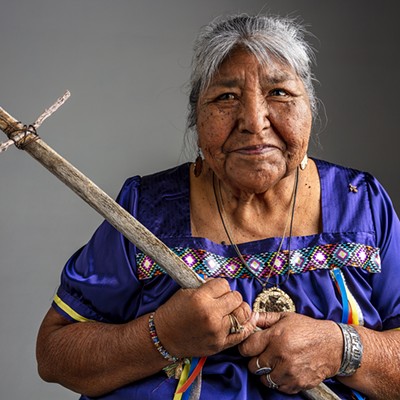Hints of incense linger in the air, and candlelight dances about the man's brown and weathered face as he nears a reclining statue of Saint Francis Xavier. His audience today includes more than 300 rustic statues, 35 lush murals and an army of cherubic angels, first brought here by Catholic missionaries around 1700.
The old man, a Tohono O'odham, retires to a pew and glances up at the east transept, or dome, where a small light shimmers down through a latticework of scaffolding and restoration equipment.
High in the recesses of this east transept, too busy to notice the old man, Tim Lewis and Matilde Rubio are helping salvage the mission from the ravages of time. In an intimate, gentle way, they're also replaying the saga of colliding cultures begun so long ago.
Lewis, 40, is a soft-spoken man with broad, tawny O'odham features and a Winnie-the-Pooh T-shirt. And he's now on his knees, testing another patch of plaster. His wife Matilde--a tiny, 41-year-old sparkplug of a woman, Spanish by birth, training and delightful accent--readies a batch of stabilizer that will eventually, painstakingly, be injected behind these loose patches.
Each summer finds them here, knee deep in the splendor of the stalwart temple. For Rubio, traveling to the Southwest from her native Spain is an adventure. For Lewis, it's repaying a favor: the mission saw him through a few ravages of his own.
Whether by heavenly fiat or simple fate, the church has helped Lewis gain himself a craft, a wife and a life.
San Xavier is like that; it has a way of tweaking the presumed order of events. This isn't surprising for an outpost that for eons has existed on the cusp of upheaval. Its walls and towers and sun-dappled plazas tell of tumultuous times and sweeping change, as Spain scuffed out a foothold here three centuries ago.
Along with Spanish explorers came Catholic missionaries, chief among them Padre Eusebio Francisco Kino, a determined Jesuit who founded the San Xavier site, another at Tumacácori and a string of lovely churches throughout northern Mexico. Many Kino mission churches were later finished by the Franciscans, in a clever architectural blending of old and new worlds: flat-roofed, rectangular structures sweep forward into graceful belfries; vigas--interior beams rooted in Islamic and Gothic styles--support ceilings of saguaro ribs, mud and straw.
A good share of those churches would be sacked and burned, by native peoples resistant to the heavy hand of Rome and Spain. Somehow, San Xavier survived. Completed after Kino's death, it's now considered the shining jewel in his crown of accomplishments, and among the finest examples of Spanish colonial architecture in the United States.
Tohono O'odham parishioners--whose ancestors helped build the church--still worship beneath the benevolent gaze of Saint Francis of Assisi, the stern visage of Santa Isabella of Portugal and the watchful eyes of many angels.
But mystery and paradox also inhabit these walls. For starters, what compelled Lewis' ancestors to help build this church? Bernard Fontana is an historian, San Xavier expert and co-founder of the group behind the restoration, Patronato San Xavier. He says creature comfort may have influenced the O'odham as much as celestial inspiration. Considered the first rancher in this region, Kino provided the Indians with the concept of livestock--a vast improvement over constantly hunting for food.
"Either way, it's clear that when the O'odham were helping to build this church, they were not doing so at the point of a gun," Fontana says.
The motivation for Tim Lewis is simpler. He signed on as a laborer when the Patronato began restoration in the early 1990s. After receiving his first paycheck, "I had to decide whether I wanted to use it for alcohol," he says, "or whether I wanted to show up for work on Monday morning."
It was a fleeting question, as the task of rescuing the mission--the place where he'd first attended mass some 30 years before--quickly seized him. And that's when life for Tim Lewis took a sharp turn. "Once I gave up the alcohol, I really started getting into the work," he says. "But the first year was the hardest. I still didn't know much about restoration."
In 1993, he says the Patronato and the Catholic Diocese helped him travel to Salzburg, Austria, for further training. While in Europe, he met Rubio, and eventually the two returned to his childhood home on the O'odham Reservation. Soon, they were married. And Rubio, the latter-day Spaniard, was quickly accepted by the Lewis family.
"I was surprised that my grandmother was so open to her, because she was very traditional," Lewis says. "It wasn't racist at all. It's just that traditional people didn't really accept outsiders. But I was pleasantly surprised--she loved Matilde.
"We didn't understand each other," Rubio says, "because she didn't speak English."
"I had to translate for them," Lewis says with a chuckle.
And Rubio marvels at Kino's accomplishments. "This is a miracle," she says. "Can you imagine that 200 years ago, in the middle of the desert, they built this? It's unbelievable."
As for the O'odham culture, "I learned about them by living with one," she says, grinning.
Now the couple spends much of the year working on conservator projects in Europe. But they return each spring to help maintain San Xavier. "It's important to me because it's something my ancestors helped to build," Lewis says. "We still have our celebrations here, and many of our beliefs have become mixed with Catholic beliefs."
He stands, one hand on the rail, as the old man far below ambles down the aisle, and out into the brilliant sun.
"We'll probably continue this work for the rest of our lives," he says. Then he turns to save the next patch of loose plaster, on the walls of a church with a long string of miracles under its belt.










